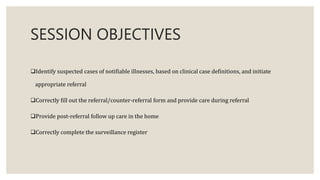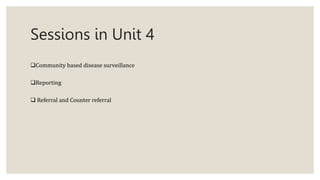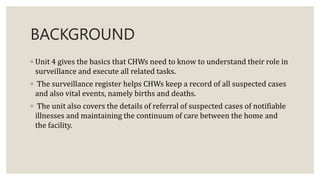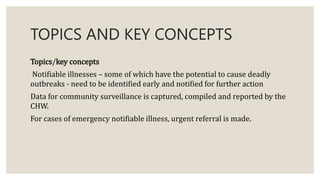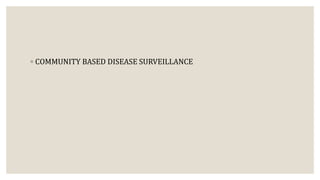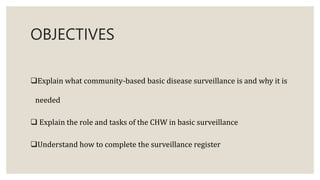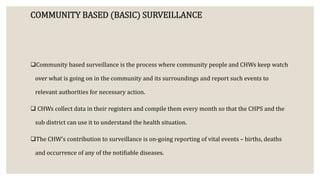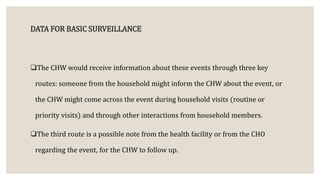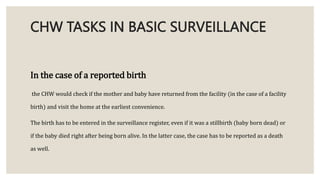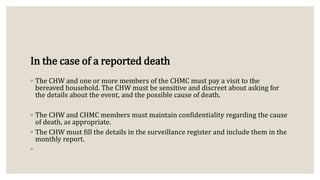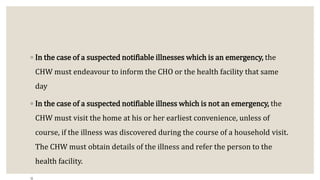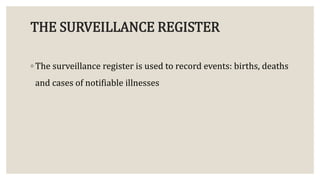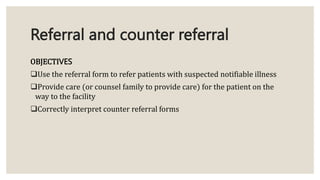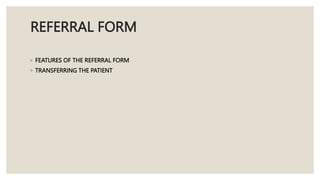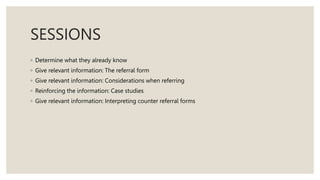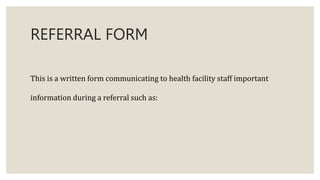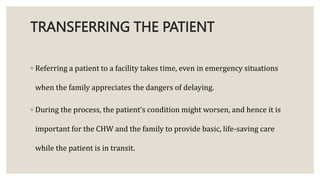Unit 4.pptx
- 1. INTRODUCING UNIT 4 BASIC DISEASE SURVEILLANCE BY MRS VIVIAN OFORI-DANKWAH GHS/FHD/HQ
- 2. Ôùª CORE COMPETENCIES Ôùª OUTLINE Ôùª INTRODUCTION Ôùª SESSION OBJECTIVES Ôùª SESSION TOPICS Ôùª KEY WORDS Ôùª DEFINITION Ôùª CONTENT
- 3. SESSION OBJECTIVES ´ü▒Identify suspected cases of notifiable illnesses, based on clinical case definitions, and initiate appropriate referral ´ü▒Correctly fill out the referral/counter-referral form and provide care during referral ´ü▒Provide post-referral follow up care in the home ´ü▒Correctly complete the surveillance register
- 4. Sessions in Unit 4 ´ü▒Community based disease surveillance ´ü▒Reporting ´ü▒ Referral and Counter referral
- 5. BACKGROUND Ôùª Unit 4 gives the basics that CHWs need to know to understand their role in surveillance and execute all related tasks. Ôùª The surveillance register helps CHWs keep a record of all suspected cases and also vital events, namely births and deaths. Ôùª The unit also covers the details of referral of suspected cases of notifiable illnesses and maintaining the continuum of care between the home and the facility.
- 6. TOPICS AND KEY CONCEPTS Topics/key concepts Notifiable illnesses ÔÇô some of which have the potential to cause deadly outbreaks - need to be identified early and notified for further action Data for community surveillance is captured, compiled and reported by the CHW. For cases of emergency notifiable illness, urgent referral is made.
- 7. Ôùª COMMUNITY BASED DISEASE SURVEILLANCE
- 8. OBJECTIVES ´ü▒Explain what community-based basic disease surveillance is and why it is needed ´ü▒ Explain the role and tasks of the CHW in basic surveillance ´ü▒Understand how to complete the surveillance register
- 9. TOPICS ´ü▒Community-based disease surveillance ´ü▒ Data for basic surveillance ´ü▒ Clinical case definitions of notifiable diseases ´ü▒ CHW tasks in basic surveillance ´ü▒ the surveillance register
- 10. ACTIVITIES Ôùª The need for community based surveillance Ôùª Clinical case definitions Ôùª Case studies Ôùª CHW tasks in basic surveillance Ôùª The surveillance register Ôùª Practice completing the surveillance register
- 11. COMMUNITY BASED (BASIC) SURVEILLANCE ´ü▒Community based surveillance is the process where community people and CHWs keep watch over what is going on in the community and its surroundings and report such events to relevant authorities for necessary action. ´ü▒ CHWs collect data in their registers and compile them every month so that the CHPS and the sub district can use it to understand the health situation. ´ü▒The CHWÔÇÖs contribution to surveillance is on-going reporting of vital events ÔÇô births, deaths and occurrence of any of the notifiable diseases.
- 12. DATA FOR BASIC SURVEILLANCE ´ü▒The CHW would receive information about these events through three key routes: someone from the household might inform the CHW about the event, or the CHW might come across the event during household visits (routine or priority visits) and through other interactions from household members. ´ü▒The third route is a possible note from the health facility or from the CHO regarding the event, for the CHW to follow up.
- 13. CLINICAL CASE DEFINITIONS OF NOTIFIABLE ILLNESS Ôùª Clinical case definitions help CHWs identify suspected cases of illnesses and notify health authorities in time for them to carry out the necessary tests to confirm the disease.
- 14. CHW TASKS IN BASIC SURVEILLANCE In the case of a reported birth the CHW would check if the mother and baby have returned from the facility (in the case of a facility birth) and visit the home at the earliest convenience. The birth has to be entered in the surveillance register, even if it was a stillbirth (baby born dead) or if the baby died right after being born alive. In the latter case, the case has to be reported as a death as well.
- 15. In the case of a reported death Ôùª The CHW and one or more members of the CHMC must pay a visit to the bereaved household. The CHW must be sensitive and discreet about asking for the details about the event, and the possible cause of death. Ôùª The CHW and CHMC members must maintain confidentiality regarding the cause of death, as appropriate. Ôùª The CHW must fill the details in the surveillance register and include them in the monthly report. Ôùª
- 16. Ôùª In the case of a suspected notifiable illnesses which is an emergency, the CHW must endeavour to inform the CHO or the health facility that same day Ôùª In the case of a suspected notifiable illness which is not an emergency, the CHW must visit the home at his or her earliest convenience, unless of course, if the illness was discovered during the course of a household visit. The CHW must obtain details of the illness and refer the person to the health facility.
- 17. THE SURVEILLANCE REGISTER Ôùª The surveillance register is used to record events: births, deaths and cases of notifiable illnesses
- 18. Referral and counter referral OBJECTIVES ´ü▒Use the referral form to refer patients with suspected notifiable illness ´ü▒Provide care (or counsel family to provide care) for the patient on the way to the facility ´ü▒Correctly interpret counter referral forms
- 19. REFERRAL FORM Ôùª FEATURES OF THE REFERRAL FORM Ôùª TRANSFERRING THE PATIENT
- 20. SESSIONS Ôùª Determine what they already know Ôùª Give relevant information: The referral form Ôùª Give relevant information: Considerations when referring Ôùª Reinforcing the information: Case studies Ôùª Give relevant information: Interpreting counter referral forms
- 21. REFERRAL FORM This is a written form communicating to health facility staff important information during a referral such as:
- 22. TRANSFERRING THE PATIENT Ôùª Referring a patient to a facility takes time, even in emergency situations when the family appreciates the dangers of delaying. Ôùª During the process, the patientÔÇÖs condition might worsen, and hence it is important for the CHW and the family to provide basic, life-saving care while the patient is in transit.
- 23. INTERPRETING COUNTER REFERRAL FORMS ´ü▒A written counter-referral (*facility discharge note), may be written by facilities, with the patientÔÇÖs consent and can communicate important information about the care of the patient which might be important for the, CHWS or family such as: condition identified, medicines being taken, possible danger signs and when to follow up at home.
- 24. KEY AREAS ´ü▒Community based disease surveillance ´ü▒Reporting ´ü▒ Referral and Counter referral
- 25. THANK YOU


